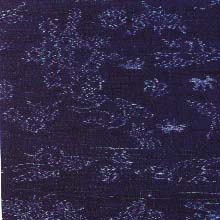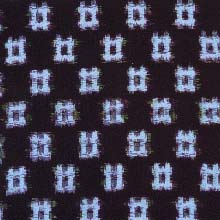Weave (p. 118 )
1. Produced in Shinichimachi Ashinagun, Fuchu City, Fukuyama City, Hiroshima Prefecture.
2. Characteristics: Cotton fabric with the designs of parallel cross or figure designs.
3. Uses: Clothing, cushion cloths.
4. History: The area was most famous for quality cotton fabrics it produced as a result of its cotton plantations since very old days. In the Edo Period, "Shiro (white) Momen.," "Asagi(light blue) Momen" and "Shima (stripe) momen" were woven. "Shima Momen," above all, was protected by the feudal government and was widely known as "Kanbe Jima (stripe)" or "Fukuyama Shima." In 1853 Kyusaburo Tomita wove "Kasuri" with a cross striped pattern with threads which are tie-dyed by hand with bamboo rinds. It was also called "Aruji Kasuri" or "Tanizashi Kasuri," which was the origin of what is today called "Bingo Gasuri." Since around 1861(the first year of Bunkyu) the Kasuri was woven with imported yarn and shipped to Osaka with the name of "Bunkyu Kasuri." It was called "Bingo Gasuri" in the early Meiji Period when its market expanded and the production process was mechanized. With the technical introduction from Kurume, the production of "E(figure) Kasuri" started. It enjoyed its height throughout Japan around 1960, however, declined after that due to decreasing demand.




